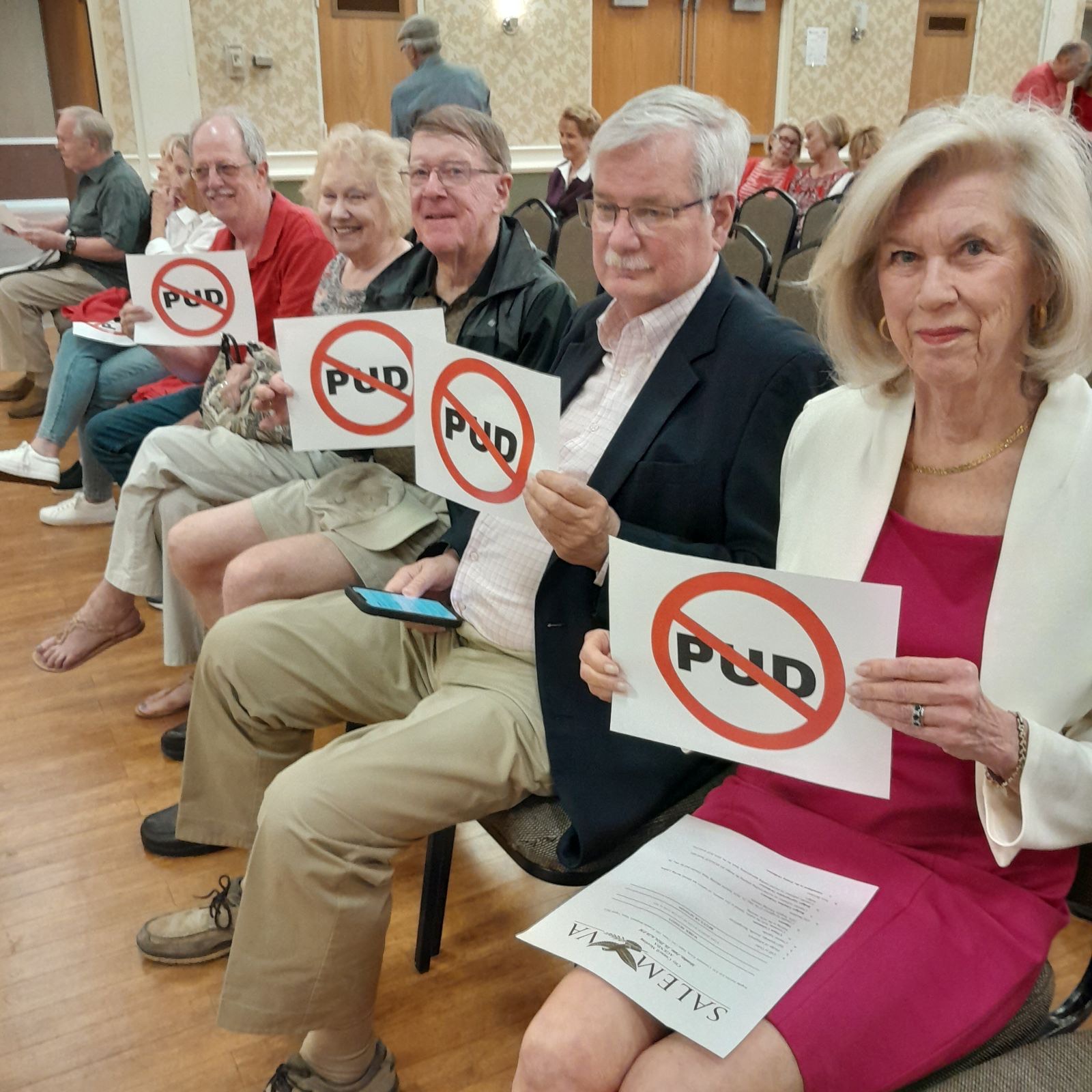
Anne Lee Stevens and others opposing HopeTree’s planned unit development request hold signs opposing the PUD at Monday night’s Salem City Council meeting before the 3-2 vote to approve the zoning change.
By Meg Hibbert
Contributing writer
It’s in the hands of developers now. Monday night Salem City Council voted 3-2 to approve HopeTree Family Services’ request for Planned Unit Development on 32 acres of the campus at the north end of Broad Street that was founded more than 100 years ago as the Virginia Baptist Children’s Home.
Mayor Renee Turk and Councilmembers Randy Foley and Bill Jones voted for the rezoning, with Vice Mayor Jim Wallace and Councilman Hunter Holiday voting against. Foley, whose family lives close to the HopeTree, made the motion for rezoning and Jones seconded.
Jones said, “We have to look at the whole, with the best use of the property.”
Two dozen audience members wore red shirts, with many holding signs saying No PUD, to show their opposition to the change.
Wallace did not speak before the vote, but explained after the meeting he voted against the rezoning “because I felt we were being asked to vote for a vision that is subject to a revision. It’s not concrete.”
During the meeting Holiday said he had conducted his own informal poll in the neighborhood, knocking on doors along nearby streets, “and people were 86 percent against the PUD rezoning and 4 percent against.”
Holiday said the proposal was not in keeping with the existing residential areas around HopeTree, along Mt. Vernon, Red Lane, Broad Street, Academy and Carrollton.
He said, “Why would we entertain building new businesses on the HopeTree campus when there are 51 vacant commercial spaces along Main Street from East Main to the brick plant?”
The mayor said she had weighed the pros and cons, and “respected the passion and input from all our citizens… We hear you…I tried to everything I could to separate opinion from facts. I do what is best for the city as a whole.” She continued, “To help taxpayers we must find other revenue sources.”
Addressing some of opponents’ concerns about runoff and traffic, she said, “If there is development it will be a gradual increase in traffic.”
Turk added, “The property is going to be developed. With PUD zoning, there will be 35 percent minimum greenspace. We have been told planned walking trails on the campus will be open to the public. Developers plan sidewalks and curbing along Red Lane. The ball fields will continue to be used by the city. Hopefully, HopeTree will remain in Salem.”
At the beginning of the meeting, Stateson Homes President Todd Robertson explained there would be a maximum of 340 housing units including single family homes, patio homes and apartments built on the 32 acres to be developed out of HopeTree’s 62 acres.
Robinson pointed out the first area to be developed would be the main part of the campus, with the steeper portion where the horse pasture is located to be the last.
He said his firm would like to have the planned coffee shop and small grocery store built fairly early.
At the April 10 meeting of the Salem Planning Commission commissioners voted 3-2 to send the proposal to Council, Todd Robertson said the PUD “It would be more pedestrian friendly” than traditional development.
Council held a public hearing on the HopeTree proposal May 13.
Early in the process, HopeTree CEO Jon Morris explained that state regulations and needs had changed HopeTree’s mission. The campus could only house 16 at-risk youth, and small group homes for developmentally delayed adults needed to be modernized. HopeTree has an academy for one-on-one instruction for area students.
After the vote Monday night, three-fourths of the audience left the meeting. In other matters, Council:
- Adopted the 2024-25 fiscal year budget, after a second reading;
- Appropriated funds for the budget;
- Adopted amended Electric Rate Tariffs;
- Adopted Miscellaneous Fees for 2024;
- Approved fiscal agreements between the city and Court Corrections Program and Cardinal Criminal Justice Academy, and
- Considered appointments to various boards and commissions
The June 10 Council meeting adjourned at 7:35 p.m.




